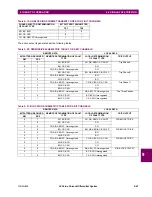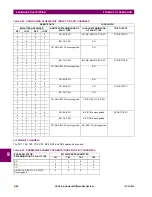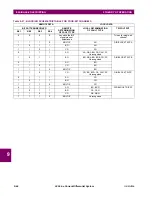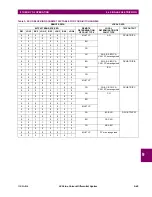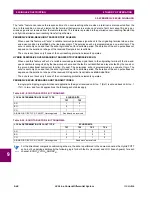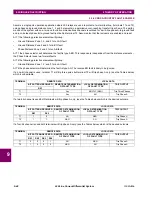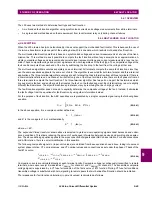
GE Multilin
L90 Line Current Differential System
9-55
9 THEORY OF OPERATION
9.6 FAULT LOCATOR
9
9.6.3 SINGLE-ENDED FAULT LOCATOR
When the multi-ended fault locator cannot be executed due to communication channel problems or invalid signals from
remote terminals, then the single-ended method is used to report fault location.
Fault type determination is required for calculation of fault location – the algorithm uses the angle between the negative and
positive sequence components of the relay currents. To improve accuracy and speed of operation, the fault components of
the currents are used; that is, the pre-fault phasors are subtracted from the measured current phasors. In addition to the
angle relationships, certain extra checks are performed on magnitudes of the negative and zero-sequence currents.
The single-ended fault location method assumes that the fault components of the currents supplied from the local (A) and
remote (B) systems are in phase. The figure below shows an equivalent system for fault location.
Figure 9–18: EQUIVALENT SYSTEM FOR FAULT LOCATION
The following equations hold true for this equivalent system.
(EQ 9.55)
where:
m
= sought pu distance to fault,
Z
= positive sequence impedance of the line.
The currents from the local and remote systems can be parted between their fault (F) and pre-fault load (pre) components:
(EQ 9.56)
and neglecting shunt parameters of the line:
(EQ 9.57)
Inserting the
I
A
and
I
B
equations into the
V
A
equation and solving for the fault resistance yields:
(EQ 9.58)
Assuming the fault components of the currents,
I
AF
and
I
BF
are in phase, and observing that the fault resistance, as imped-
ance, does not have any imaginary part gives:
(EQ 9.59)
where: Im() represents the imaginary part of a complex number. Solving the above equation for the unknown
m
creates the
following fault location algorithm:
(EQ 9.60)
where
*
denotes the complex conjugate and
.
mZ
(1-m)Z
R
F
Z
A
Z
B
E
A
E
B
V
A
V
B
V
F
I
A
I
B
Local bus
Remote
bus
distance to fault
842780A1.CDR
V
A
m Z I
A
R
F
I
A
I
B
I
A
I
AF
I
Apre
I
B
I
BF
I
Apre
R
F
V
A
m Z I
A
I
AF
1
I
BF
I
AF
--------
-----------------------------------
Im
V
A
m Z I
A
I
AF
-----------------------------------
0
m
Im
V
A
I
AF
Im
Z I
A
I
AF
----------------------------------------
I
AF
I
A
I
Apre
Summary of Contents for UR Series L90
Page 652: ...A 16 L90 Line Current Differential System GE Multilin A 1 PARAMETER LISTS APPENDIX A A ...
Page 772: ...B 120 L90 Line Current Differential System GE Multilin B 4 MEMORY MAPPING APPENDIX B B ...
Page 802: ...C 30 L90 Line Current Differential System GE Multilin C 7 LOGICAL NODES APPENDIX C C ...
Page 812: ...D 10 L90 Line Current Differential System GE Multilin D 1 IEC 60870 5 104 APPENDIX D D ...
Page 824: ...E 12 L90 Line Current Differential System GE Multilin E 2 DNP POINT LISTS APPENDIX E E ...
Page 834: ...F 10 L90 Line Current Differential System GE Multilin F 3 WARRANTY APPENDIX F F ...
Page 846: ...xii L90 Line Current Differential System GE Multilin INDEX ...

